Horseadvice is organized by topics and searchable. A discussion area is provided with each topic where members can receive help solving problems. All moderated by an experienced equine veterinarian since 1997.
Come see what you have been missing.
Site Menu:
| This is an archived Horseadvice.com Discussion. The parent article and menus are available on the navigation menu below: |
| HorseAdvice.com » Diseases of Horses » Lameness » Diseases of the Hoof » Hoof Disease Topics Not Covered Above » |
| Discussion on Farriers/vets stumped hoof sole/wall defect | |
| Author | Message |
| New Member: hollyh |
Posted on Tuesday, Apr 17, 2012 - 9:44 pm: 16 y/o Spotted saddle with hx of WLD in R front hoof. Was out 24/7. Large resections X4. Coffin bone rotation 8-10 degrees. Used every product imaginable or suggested X 4 years. Have had 5 vets/ 7 sets of RADs/ 4 farriers. After 1 1/2 years in one boarding facility, moved to new one with new farrier and 12 hr night stalling. Hoof wall seemed to get better for about 1 1/2 years but has always had a sole defect (black line running from sole to coronary band) that needed to be pared out each trimming (5 weeks- I live in SE.) Still treat for WLD even though newest vet says that RADs show no sign of active WLD. Two trimmings ago, the good hoof started developing the same 'defect' in the same spot. This hoof has no rotation and no history of WLD. Vet and farrier say that RADs do not show any Keratoma... They are baffled. Latest vet suggested 'Natural Balance' shoes to keep pressure off of toes. He has had these only 1 week. Everybody is still scratching their head as to what this sole defect is. Nobody has seen anything similar. If anybody has any ideas of what this may be or what it is not, would appreciate any input. Horse has never taken a lame step in the 8 years of owning him....even after having 3/4 of his hoof resected sole to band, and even after rotation. (latest vet says he has an old navicular fx- no other vet found this with RADs) Wears front only shoes. Tried barefoot for about 1 1/2 months but his feet started to fall apart. Will attempt attachments.
|
| New Member: hollyh |
Posted on Tuesday, Apr 17, 2012 - 9:49 pm: not allowing me to upload at this time??? Will try again in am. EST |
| New Member: hollyh |
Posted on Wednesday, Apr 18, 2012 - 10:00 am: 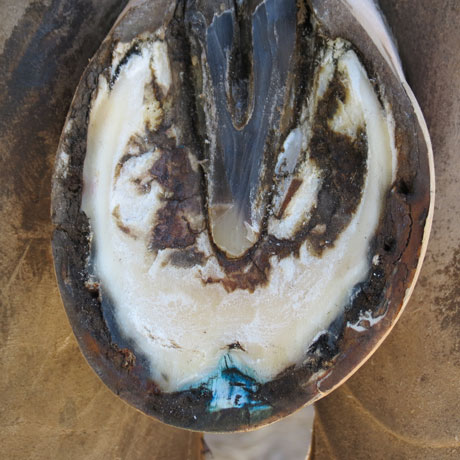 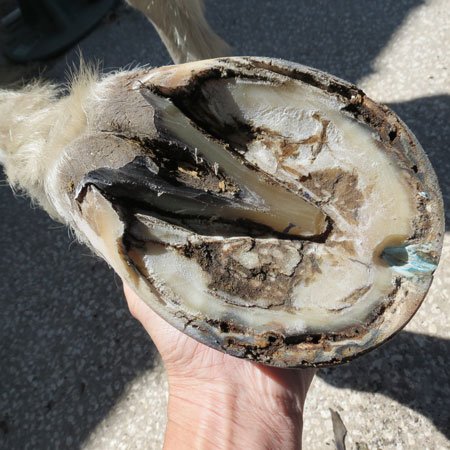  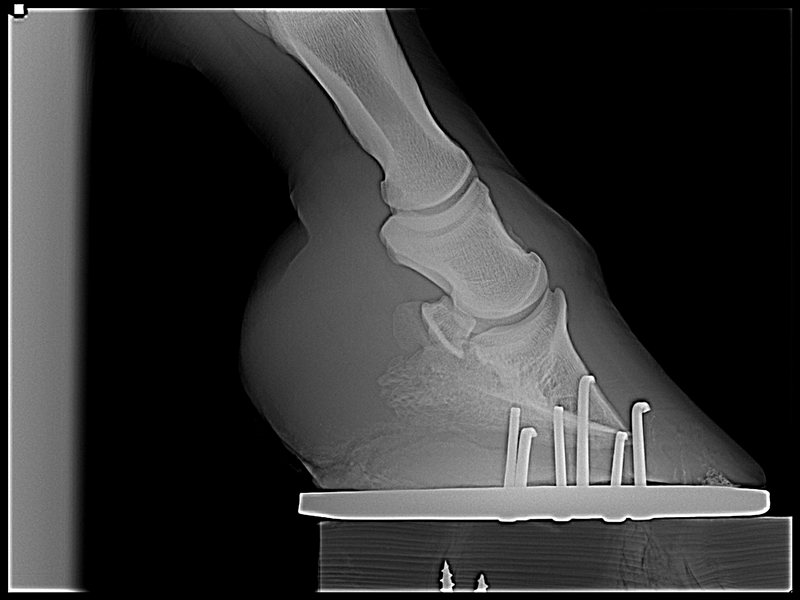 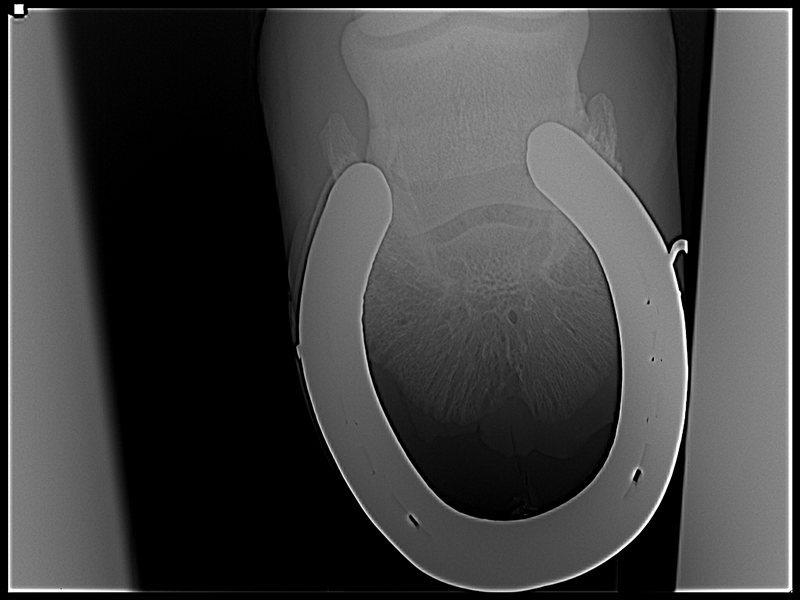
|
| New Member: hollyh |
Posted on Wednesday, Apr 18, 2012 - 10:12 am: 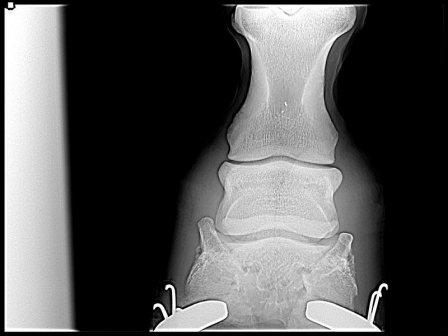
|
| Member: juliem |
Posted on Wednesday, Apr 18, 2012 - 10:33 am: Welcome to the board Holly. I think those pictures do tell a story and the radiographs ad some info. This is one Dr. O needs to weigh in on. My totally amateur is the farrier doesn't have the breakover in the right place and the palmar angle is too steep. I don't know if that has anything to do with the defect. Do you have him shod with high heels for gait enhancement? Looks like they are high. At any rate, welcome and hope you find some answers. |
| New Member: hollyh |
Posted on Wednesday, Apr 18, 2012 - 11:33 am: The RADs are from 3 weeks ago before we reshod with Natural Balance shoes. Farrier admitted that heel was too high/toe too long. Working at taking toe/heel down slowly to better the angle. I do not gait with him as I prefer the posting trot and he has mostly lost his gait. He is purely a pleasure trail horse. I did notice that since the new shoes, when I canter him, he holds his head in normal mid line position....before he always held his nose toward ground. Thinking the new shoes are teaching him to put more balance on hind limbs and not so much on front??? Just spoke with farrier today and he is not fan of Natural Balance shoes but wants to make his own with same idea....setting shoe back the same amount that he can safely take off heel. Farrier went to conference this weekend and nobody there could say what is going on with the foot (never seen what is going on in toe before) and agreement seems to be....When he dies, lets to a biopsy. Not accepting that
|
| New Member: bluejean |
Posted on Wednesday, Apr 18, 2012 - 11:49 am: Those heels are high, the breakover is too far forward. I have seen this type of "hole" before and was able to get rid of it with proper placement of the breakover. Those bars need help too! It would be nice to see side views of the hoof too. The bars need to end half way down the frog.https://www.hoofhelponline.com/ this site has tons of great info. This is most probably a breakover issue in my professional opinion. JoAnn |
| Member: hollyh |
Posted on Wednesday, Apr 18, 2012 - 12:50 pm: Thanks! I will take photos tomorrow am and post later as vet is coming out for shots. They will be photos of hoof in Natural Balance shoes X 7 days. RADs above are in original shoes per how farrier was shoeing him. I was wondering if too much toe pressure could be causing a breakdown of the horn tissue in the toe/sole area??? The vet was suggesting that the rotated RF coffin bone could have some deterioration at the tip and might not be producing healthy horn in that area but this would not explain the new development of his healthy LF hoof doing the same thing. Thanks so much for website info! |
| Member: dres |
Posted on Wednesday, Apr 18, 2012 - 1:33 pm: Not a fan of natural balance shoes either ... feel your farrier can set a shoe further back without the fuss of the fancy shoe ... used then for 6 months with no improvement , even went back wards in his healing .. good luck ..On the first day God created horses, on the second day he painted them spots.. |
| Member: hollyh |
Posted on Wednesday, Apr 18, 2012 - 2:25 pm: Xray of LF 'good' foot for comparison and thoughts about breakover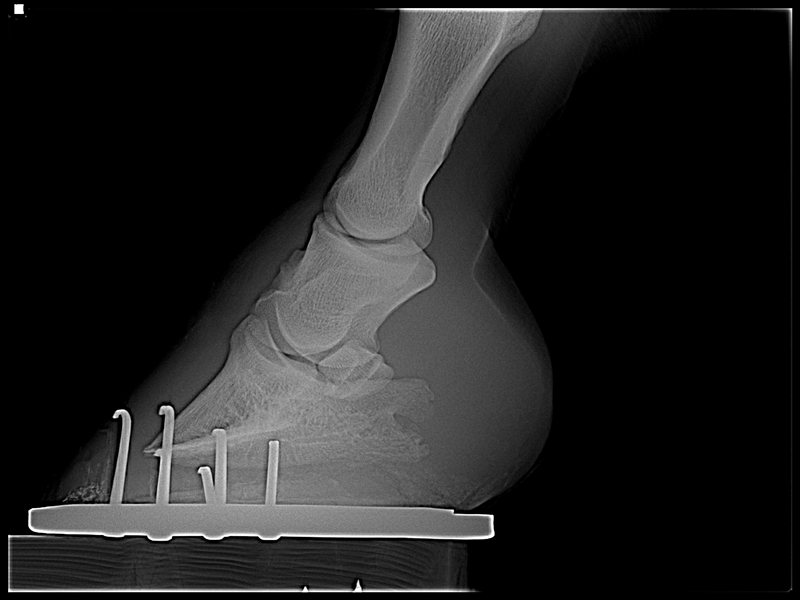
|
| Member: juliem |
Posted on Wednesday, Apr 18, 2012 - 3:44 pm: I've used natural balance shoes with great success, but they weren't put on like these. They are not meant to be set like a traditional shoe. If a farrier doesn't know how to put them on properly, they wouldn't be much help. At the time I had a horse with hoof issues, I found a farrier who had been to several of Gene Ovenics clinics. Big improvement for my foundered horse with rotation. |
| Member: juliem |
Posted on Wednesday, Apr 18, 2012 - 3:45 pm: In the rad of the good foot, it clearly shows the shoe set too far forward. |
| Member: hollyh |
Posted on Wednesday, Apr 18, 2012 - 4:03 pm: Thanks for your input. Please note that the Rads above were taken 3 weeks ago. The horse was reshod with Natural Balance 1 week ago. I will take photos tomorrow am and post them of shoe placement. Thanks! |
| Member: stek |
Posted on Wednesday, Apr 18, 2012 - 6:26 pm: Holly, my mare has a similar defect in her RF, and another boarder's horse has one in his LF. I think it is actually not all that uncommon, my farrier said it was more common in horses with an upright foot. If I remember right Dr O suggested it was a defect in the tip of the coffin bone, I will have to dig up the old discussion.My mare is kept barefoot and if I keep her toe short the defect and associated crack goes away mostly. In the 7 years I've owned her it comes and goes and hasn't caused any problems aside from looking odd. |
| Member: stek |
Posted on Wednesday, Apr 18, 2012 - 6:32 pm: Holly the other thread I mentioned:https://www.horseadvice.com/horse/messages/4/351383.html |
| Member: hollyh |
Posted on Wednesday, Apr 18, 2012 - 9:56 pm: Thanks! He does not have an associated 'crack' on the front surface of his hoof. The sole defect is like a black vein of 'something' that travels up the hoof wall and if left untreated seems to spread. Vet claims it is not WLD???? I have used every product imaginable on this blackness: White Lightening, Clean tracks, Copper sulfate and vinegar, 7% iodine, Chlorahexadine, all human foot fungus sprays available over the counter, all thrush products available, 'sugardine', and at the moment...Clorapactin and excavation. Nothing eliminates it. I will post hoof photos tomorrow. Thank you for your input!! |
| Member: hollyh |
Posted on Thursday, Apr 19, 2012 - 2:29 pm: Photos one week after Natural B shoes.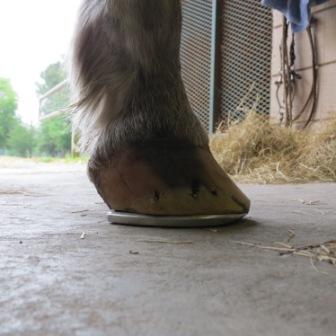 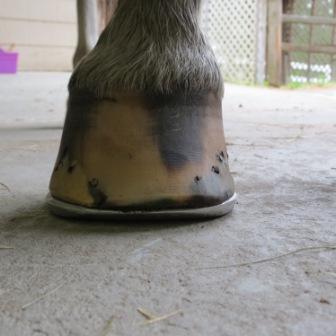 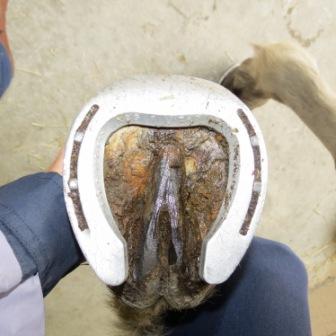 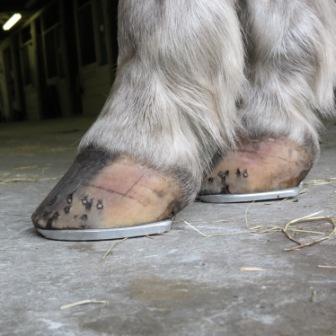 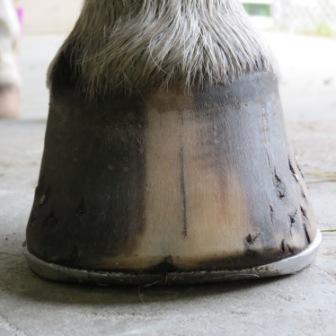 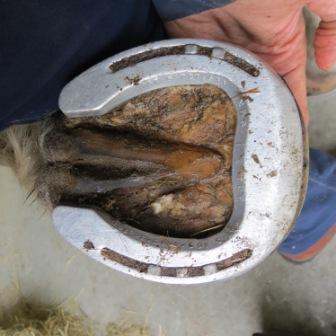 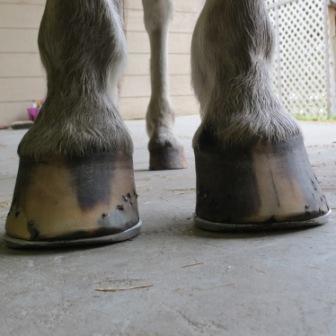 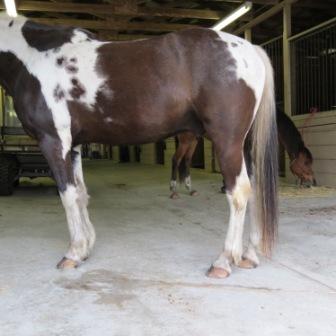
|
| Member: dres |
Posted on Thursday, Apr 19, 2012 - 3:18 pm: i will be interested in others on these recent pix .. it appears to me that he does not have enough heal support .. also the toe does not look right ...nor does the hoof look balanced . . . but i am just a horse owner that has battled shoeing for years too .. am always learning...On the first day God created horses, on the second day he painted them spots.. |
| Moderator: DrO |
Posted on Thursday, Apr 19, 2012 - 6:57 pm: Welcome Holly,The photos of the defect above and your description (black vein of stuff) strongly suggest a thrush infection that probably got started with damage to the sole and/or white line. It allowed the thrush to get started and it has ate away at the horn. This could be the results of abnormal shoe pressure as some suggest above. Paring out the infected material, treating as described at HorseAdvice.com » Diseases of Horses » Lameness » Diseases of the Hoof » Thrush should allow normal horn to grow out. DrO |
| Member: rtrotter |
Posted on Thursday, Apr 19, 2012 - 7:25 pm: Ok, time for me to chime in.This horse does not have healthy feet! In some of the pictures I see a tint of red, that I do not believe should be there. If you look at the first picture in the set, you can see the deep slope of what appears to be a foundered foot. You did say he had some rotation. It also looks like the farrier rasped down from the top instead of up from the bottom in an attempt to make the hoof match the shoe. That weakens the hoof wall and compounds the problem. IMO he should rocker that toe back( from the bottom so you can see where the hoof wall is), take down the heels, make sure the heel points are where they are supposed to be and balance the hoof. My last comment, is that it appears the shoes are too big for your horse and your horses feet are compensating by growing down to the shoe. And don't let me get started on the nail holes, thats a whole nuther post. With Natural Balance shoes, it is very important for the trim to be right and from what I see this is the problem with this horse. I do not think the type of shoe makes a difference, if there is not a proper trim, the horse will continue to have problems. All the best Rachelle |
| Member: vickiann |
Posted on Thursday, Apr 19, 2012 - 8:17 pm: Poor horse. These feet look horrid.If the horse has had rotation they have not been properly addressed to de-rotate. Back up the toe and take the heels down too. IMHO the stress at the white line is in part caused by the heels being too high. The feet are distorting. |
| Member: hollyh |
Posted on Thursday, Apr 19, 2012 - 9:07 pm: Thank you Dr. O. Since he had this long history of WLD and has rarely showed any sign of thrush on his sole/frog I never questioned whether that black line up the front of the hoof could be thrush. I have been spraying Clorapactin on any open hole/crack/under shoe. I will start pouring thrush solution on it after next paring.RTrotter...Thanks for your assessment and advice. Most especially thanks for the laugh. I am as frustrated as you appear to be at the appearance of the feet. I have pointed out these same issues to the farrier. The red tint on the hoof was explained to me as 'It's normal...all horses get these, it just shows because he has white feet'. I've asked about glueing shoes and he is adamant that they will not stay on on the humid climate we live in and that the glue will trap any organism in the hoof and cause an anaerobic condition good for WLD'. As I watched the shoeing/toe rasping, I would say you are correct and rasping was done top/down.  Sadly, I think I am using the best farrier in my area. He is willing to work with me and listen to/answer my constant questions but he holds the cards and I walk a fine line as I have no other options. To his credit...He knows he needs to take down the heels and take off some toe. He just doesn't want to lame the horse by doing too much too soon but I know very little about trimming feet and this is why I am asking for input. I thank you all for it! Sadly, I think I am using the best farrier in my area. He is willing to work with me and listen to/answer my constant questions but he holds the cards and I walk a fine line as I have no other options. To his credit...He knows he needs to take down the heels and take off some toe. He just doesn't want to lame the horse by doing too much too soon but I know very little about trimming feet and this is why I am asking for input. I thank you all for it!
|
| Member: rtrotter |
Posted on Thursday, Apr 19, 2012 - 9:58 pm: Hi Holly,Remember that nail hole discussion I said was a whole nuther post, well we are about to have it. First, as to what your farrier said about the glue on shoe's, he is right in one respect, unless your horses feet are clear of any infection, glueing the shoes on does trap the infection and will not allow the hoof to breathe and you will most likely wind up worse off. Glue-ons work best on feet that have no nail holes and no infection. The nail holes create most of the problem and some farriers create the rest of the problem by not addressing the infections in the first place and because they have to remain on their own schedule will shoe or glue a horse that has no business being shod. Your horse's feet need to be rehabilitated to get them to the point where you can fix his rotational problem and this will take time. I think its time you go to plan B. Pull the shoes, find a good barefoot trimmer and get him a pair of boots, if you need to ride. A set of Easyboot gloves with gaiters, should do the trick and just think about all the money you'll save by not shoeing him. Once his feet get healthy, you may be able to get back to shoes, but you'll be so happy and he'll be happy, you probably won't want to ruin what you just fixed.  Rachelle |
| Member: hollyh |
Posted on Thursday, Apr 19, 2012 - 10:34 pm:  Thanks. I actually have pulled his shoes and watched for about 8 weeks while the hoof broke apart. Possibly I needed to wait longer.?? I've used/own easyboots and MAC boots. I've been told by all farriers that the horse will always be in shoes because of that rotation to keep him comfortable and to keep pressure off of the toe. I really am not dealing with backyard farriers either. 1 Journeymen, 1 works strictly at a Vet facility only with thaerapeutic/shoe horses and then my 'home' vet that does actually attend continuing education (sometimes from afore mentioned farriers) and seems to take advice despite his prideful knowledge. Thanks. I actually have pulled his shoes and watched for about 8 weeks while the hoof broke apart. Possibly I needed to wait longer.?? I've used/own easyboots and MAC boots. I've been told by all farriers that the horse will always be in shoes because of that rotation to keep him comfortable and to keep pressure off of the toe. I really am not dealing with backyard farriers either. 1 Journeymen, 1 works strictly at a Vet facility only with thaerapeutic/shoe horses and then my 'home' vet that does actually attend continuing education (sometimes from afore mentioned farriers) and seems to take advice despite his prideful knowledge.  The consensus is that I live in such a moist, humid climate (SE GA) and in this climate this horses hoof wall cannot be stable, and when using boots...they trap moisture in the hoof and do not allow it to breathe/dry. (perfect environment for WLD/thrush) All claim that barefoot will hurt more than help. I have talked with a 'barefoot' farrier who tells me 'he can fix it'. I've just heard that before and I am never sure if this is a 'barefoot vs shoe' rivalry as I can and have always just assumed that these farriers know much more than me about horse feet given their 18 plus years of working on them but they never can agree on anything. I certainly have another horse to ride (daughters) just not sure how 6 months pasture rest will help or hurt the situation. The consensus is that I live in such a moist, humid climate (SE GA) and in this climate this horses hoof wall cannot be stable, and when using boots...they trap moisture in the hoof and do not allow it to breathe/dry. (perfect environment for WLD/thrush) All claim that barefoot will hurt more than help. I have talked with a 'barefoot' farrier who tells me 'he can fix it'. I've just heard that before and I am never sure if this is a 'barefoot vs shoe' rivalry as I can and have always just assumed that these farriers know much more than me about horse feet given their 18 plus years of working on them but they never can agree on anything. I certainly have another horse to ride (daughters) just not sure how 6 months pasture rest will help or hurt the situation. Currently the horse is stalled at night for 13 plus hours to dry out the feet. Thanks for the nail hole advise though....I understand and have thought the same. |
| Member: gramsey1 |
Posted on Friday, Apr 20, 2012 - 5:03 am: Looks like Thrush to me too (along with some hoof balance and trimming problems).I had good success eliminating it from the hoof with Tomorrow and Clean Trax. But, it would come back. Then, I tried cleaning the stall mats with bleach. Problem solved. As for barefoot, yes, after you pull the shoes things fall apart for a couple of months then, if the hoof is not diseased and can grow back, it will. |
| New Member: always |
Posted on Friday, Apr 20, 2012 - 5:38 am: Hi Holly, after seeing your photos and xrays it brought to mind my former competition horse who had a club foot. It looked exactly like the photos of your horse's feet, and the xrays of his foot also showed the same slight rotation. He also had a high heel and toe separation problems, which I discovered through my research are related to the general hoof imbalance from the internal rotation. The rotation puts abnormal stresses on the front of the hoof. You might research the shoeing of low grade club feet, as that might help you decide the best approach to trimming and shoeing. I know barefoot was definitely not an option for him. |
| New Member: bluejean |
Posted on Friday, Apr 20, 2012 - 6:05 am: OK Holly here are some things that I noticed with the trim that need to be addressed. If you have boots I would pull shoes and only use boots when riding on ground that is uncomfortable for your horse. And let him be barefoot in the pasture. I live in northern mn and my horses spend A LOT of time on wet clay ground (muck this time of year), as that is all we have. Their feet do not fall apart. We compete as well and never have a problem.However the problems here are not so much that your horse is shod as there are major imbalance problems going on. The "hole" and thrush are just a symptom of that imbalance not a problem in their own right. Get rid of the imbalance and they will also go away. I have included some quick markups from your photos. Please ask questions if you have them. Also I would ask the barefoot trimmer for some references, and if good go that route. Especially if your farrier is resistant to doing what you want. Also get informed, do some research, the vet and farriers are professionals yes but you need to know what a good balanced hoof looks like so that you can be more informed about your horses care. The website I linked earlier is a great resource! [IMG]https://i1093.photobucket.com/albums/i440/SimplyAsteel/hoofmarkup.jpg[/IMG] [IMG]https://i1093.photobucket.com/albums/i440/SimplyAsteel/hoofmarkup2.jpg[/IMG] |
| New Member: always |
Posted on Friday, Apr 20, 2012 - 6:27 am: Holly, I would really caution you against radical intervention in the exterior shape of the hoof, in a well-intended but misguided effort to reach a "balanced" hoof. The shape of your horse's hoof, with the high contracted heels, short toe, abnormal forces, and subsequent toe problems, is a reflection of what is going on inside. It cannot be remedied by simply changing the exterior angles, as if it is merely a trimming issue. Trying to make abnormal feet look "normal" is a sure recipe for disaster. |
| New Member: bluejean |
Posted on Friday, Apr 20, 2012 - 6:38 am: Also, when you went barefoot last time, how was the trim. Same long toe and high heels? If so, then it was the improper trim NOT being barefoot that was causing problems for your horse.Either way, the trim is the most important part, not shoes or barefoot. Get the trim right and that hoof horn will grow in tight and strong. There is strong leverage force on the toe when it is way forward as it is here. You have to remove that leverage in order to heal the hoof. I will just assume that his nutrition is good with out too much sugars and balanced minerals. Because if something is amiss here it will also show up in the feet. JoAnn |
| New Member: bluejean |
Posted on Friday, Apr 20, 2012 - 7:11 am: Jane the long-forward toe and high heels here are the problem and the only way to correct it is to remove it. I have seen this exact issue and have successfully remedied it.Of course you can just keep doing what your doing and get the same results as you've always gotten. Holly, this is were you need to be as informed about proper hoof form and function as you can. By all means I hope you just don't take my word for it. Do some research. There is a ton out there. May the path you take lead you and your horse to soundness. Do some research on laminar wedge here is another great source of info https://www.hoofrehab.com/ I hope this leads you on a journey where you will learn tons about hoof and horse health and proper loading of the hoof capsule. You can never be too informed as to the health of your best friend and companion! JoAnn |
| Member: rtrotter |
Posted on Friday, Apr 20, 2012 - 7:36 am: Rehabilitating a horses feet takes time, so I don't feel anyone here is suggesting to do anything drastic. Well trained and knowledgeable barefoot trimmers, trim with the horses well being in mind and use a trim that suits each hoof of the horse.As to your horses feet falling apart when barefoot. I see this happen all the time because a farrier puts a field trim on a horse(shoes pulled, feet trimmed, hoof wall edges not rolled, horses feet not touched for several weeks). The nail holes start to grow down, feet are not addressed and the hoof starts to break apart. This always leads to the farriers comment of, see I told you your horse could not go barefoot. If instead, you pull the shoes, trim and bevel the toes and come back every 10 days with a riders rasp just to bevel the hoof wall edges, the cracks are taken care of and your horse grows a healthier foot that will not fall apart unless there is something systemically wrong with your horse. Also, please note, that although I prefer barefoot, my issue is not with shoes it is with nails in an unhealthy hoof which only compounds the problem. I have racehorses who race on very abrasive stone dust tracks who need shoes. The difference is mine actually has a barefoot trim with rockered toes on all 4 feet, I use baby nails as few as possible and clips. also to prevent the long toe low heel synDrOme, the shoe ends in the proper place and her hoof does not grow down to meet the shoe which the causes other problems. Anyway just my thoughts Rachelle |
| New Member: bluejean |
Posted on Friday, Apr 20, 2012 - 8:10 am: Rtrotter i agree. |
| Member: ajudson1 |
Posted on Friday, Apr 20, 2012 - 8:48 am: I had a long response here, and wasn't logged in! Crap, let me see if I can try again.Those hooves need work, the heels are too high, the toe is pulling forward due to the heels and bars causing that, and the toe needs to be backed up. The wall needs to be taken down all around, and a good bevel put on all around, including the heels. See in the side view how he is standing under himself? See how his shoulder is tense? He's in pain because hoof form is incorrect and shoes are only making it worse. (IMO it should be a crime for farriers to shoe horses leaving the hoof too long, heels too high, etc. Shoes do NOT solve anything except make farriers money. Boots help. With the exception of a horse on very gritty surfaces, like Rachelle's trotters, NO SHOES) With a proper trim, and maintenance, "WLD" "thrush" will not be a problem. Those things cannot take hold in a tight WL, and healthy frog. An unhealthy frog is usually caused by bars pinching off circulation to the frog, get the bars done correctly, a heel first landing, and the frog will become healthy. All the hoof concoctions in the world won't cure those problems if you don't correct the trim. And they also eat away at healthy material. If you feel you must be spraying something on those hooves, TTO, ACV, and a product called "No Thrush" which is dry power, are my suggestions. Keratox Hoof Hardener on his soles might help. Keeping the outer wall beveled all around, including the HEEL, will let the hoof wall grow in straight and tighten it up. You will need to learn how to bevel because you might need to tweak every 2 weeks or as often as twice a week..same with bars; if they keep popping back they will need to be addressed, not only shortened up but shaped which I won't try to explain since bars are the most confusing part of trimming to learn! And the most important. This horse has a long road ahead of him; if you keep trying to find answers with shoes, it will be longer. Pull the damn shoes, learn what a healthy hoof is supposed to look like, and find a good barefoot trimmer...A CERTIFIED barefoot trimmer, and become a hands on hoof person. As suggested above, and for the sake of your horse, join www.hoofhelponline.com read and study the material, post pictures and ask questions. Even if you never take on all the aspects of trimming yourself, at least you will be able to point out what you want done and why. There are articles, videos, and pictures along with personalized advice if you post in the forum. Run by an experienced, certified, well traveled, barefoot trimmer. Good luck. "Happiness is Healthy Barefoot Hooves!" |
| Member: natalya |
Posted on Friday, Apr 20, 2012 - 11:15 am: I also have club foot horse, when I got her she were slightly lame , her heels was ridiculously tall, hoof are cracked all the time one of my Ferrier, I used to have 2 of them one is orthopedic Ferrier he trims our Arab with joint problems( he didn't take clients that time) so long story short, he started to trim her heels down, she got lamer and lamer after each trim, then one day she couldn’t walk at all, she was trimmed to short, I asked my other Ferrier to look at her. He sad it’s a very sloppy trim, and her hoofs each one is different, they can't be trimmed the same. That when I found out that she is club foot, and her heels has to be kept long. After couple of months, she is no longer lame, bare foot and her hoofs are not cracked. Of course Ferrier #1 got fired.Fish you best. |
| Member: hollyh |
Posted on Friday, Apr 20, 2012 - 11:51 am: Wow! Thanks for all advice. Will try to address some....Do not have stall matts...only shavings on top of clay that is cleaned daily. He does LOVE to pee in there.  Wondered if stall matts would be better for him or pea gravel. Wondered if stall matts would be better for him or pea gravel. Both of my farriers say they are going to work together (miracle) on May 11th. Both admit trim/balance issues and that 'hole' is a symptom of that imbalance. Also admit that the problem is coming from the rear of the hoof frog/bar and creating problems for the front. Joann..When I pulled shoes he was probably not wall beveled all around..probably just a pasture trim with longish toes. (That was first farrier who completely didn't notice that 3/4 of horses white line had been eaten away-I no longer use him- but I might add he is who everybody in my area said was 'the best') Also want to let you know that out of 7 vets....only 1 said 'sure let's try pulling the shoes'. All others said 'this horse must have shoes'. This is why I have stayed with shoes...because 6 Vets and 5 farriers have told me to. Horses nutrition is good. Fed ADM GroStrong Ultra fiber with Coastal hay (2-3 flakes in stall) plus Formula4Feet hoof supplement and Cosequsequin ASU. I have posted on Horseshoes.com and have just gotten farrier banter between farriers but nothing specific about the hooves or my issue. Lots of pride in that forum  I will try the other above mentioned sites...thanks! I will try the other above mentioned sites...thanks! Angie...I see what you are saying about him 'standing under himself' in the front but I also am questioning if that is because the slope of that barn floor is slanted slightly for runoff.??? Joann....I will look at the markups you made me. (running around today( I appreciate you taking the time to do that! |
| Member: hollyh |
Posted on Friday, Apr 20, 2012 - 12:12 pm: Wow! Thank you Joann! I have printed those off and will attempt to see what farriers think That was a wealth of information. Will begin doing more research and being more forceful with any farriers. I may contact you again if they give me their answers and they don't agree. Each time I ask about the bruising, the dishing, the heels or the 'jamming up' at the cornet....they give me answers that sound plausible and I can't refute them. That was a wealth of information. Will begin doing more research and being more forceful with any farriers. I may contact you again if they give me their answers and they don't agree. Each time I ask about the bruising, the dishing, the heels or the 'jamming up' at the cornet....they give me answers that sound plausible and I can't refute them.
|
| Member: rtrotter |
Posted on Friday, Apr 20, 2012 - 7:12 pm: Hi Holly,I'd like to give you my opinion of most vets and most farriers(notice I say most and not all). They do not make money on healthy horses. If your horses feet need help, farriers are the first to say you need therapeutic shoeing. Why? because by saying that they can charge more each time they come to shoe because to them they are performing a higher level of service, then just nailing on 4 shoes or telling you you need to leave the shoes off your horse. Several years ago I had a 2 year old colt who was broke and jogging barefoot. One of the best farriers on the East Coast happened to be at the farm and I asked him to take a look at my colts feet. He told me they looked wonderful and healthy. He said it would be great for racehorses to race barefoot, then he said but then he wouldn't make any money. He gets paid to fix all the awful feet caused by other poor farriers(and the trainers who allow poor farrier to work for them, mainly because they don't know any better on how to fix the problems) These are the same farriers who think that because they shoe horse's that make a lot of money, that they know everything.(Its really an ego thing with them). I have given up talking to farriers, except my own who listens to me and does what I ask him to do. I really do not want to waste my time with farriers who are not willing to listen and maybe learn something. it's their loss, not mine. My take on this whole thing is if all the foot problems were prevented in the first place, or fixed so they would not reoccur we would have much happier horses which we would be able to enjoy for longer periods of time. The fact that all those farriers and vets told you your horse needed shoes, does not surprise me one bit. Rachelle |
| Member: vickiann |
Posted on Friday, Apr 20, 2012 - 7:39 pm: In my experience when something breaks up on a horse's foot it is because it needs to go. This is not a bad thing and left to nature taking the lead that is what would happen.Had that experience here in my VA mountain home last summer. Farrier I got up here (AND the Vet, thought that my previously laminitic (metabolic issues) horse needed to have higher heels and one of those heels really just plain blew out. The higher heels also put much more strain on the sole and the white line. Farrier here in VA had success getting his heels higher but it was the worst thing for my horse. When my FL farrier got the heels back down again my horse was running around happily again. |
| Member: gramsey1 |
Posted on Friday, Apr 20, 2012 - 9:30 pm: Agree with Viki here, by experience. Some of that breaking down is a normal reaction to taking the metal off. Agree with Rachelle, as I usually do, most horses do not need shoes. Shoes can enable the hoof to do work that, perhaps, it could not otherwise do. But, at what cost? Your horse has compromised hooves. You gotta get control of that. At the same time, focus on a good balanced trim, base on the conformation of the horse, not automatically assuming that the horse has classic conformation or will ever have the hoof ever conform to it. Many factors come into play. |
| Member: paul303 |
Posted on Saturday, Apr 21, 2012 - 1:25 am: My thoughts: ( having dealt with ugly feet for over 40 years )Too much toe. As someone noted above: when you get too much length and improper trim, you get hoof deformities and pathologies. The shoeing, especially with the New Balance shoes, is too flat. Try strapping two pieces of plywood to your feet and walking a mile. You'll learn all you need to know about delayed breakover real quick.I would hot shoe with a rolled and rockered toe pushed as far as possible the first time and gently increasing in subsequent shoeings. The tiny bit of easing evident in these New Balance shoes and "mustang roll" is negligent and ineffective. There is no hoof that will suffer from easing breakover, and nearly 100% will benefit - especially when toe pathology is involved. If some of the excess pressure caused by the delayed breakover is removed from the toe through rolling and rockering, the pathology may correct itself. Your horse may not stand so much "under himself"in front, and it should free his shoulders up a bit - an added bonus. I would be a bit uneasy about removing shoes in the presence of the kind of pathology illustrated by your pictures...especially since the defect has a considerable history. Should you not be able to find someone who can deliver a really good trim, the rolling and rockering will, at least, ease the excessive toe pressure. Wish you lots of luck. A foot problem is never between you and your horse, it is always between you, your horse, your farrier, and your vet...and the 4 of you all have your own ideas.... |
| Member: ajudson1 |
Posted on Saturday, Apr 21, 2012 - 9:04 am: Holly,I would strongly suggest reading "Shoeing, A Necessary Evil" by Dr. Strasser, and if you can find it,and afford, her other book "A Life Time OF Soundness" You need to understand what putting a steel (Aluminun, plastic, don't matter) shoe on a hoof does. Everytime you fall back on shoes, you set those hooves back in their journey to becoming HEALTHY and able to function. Oh a horse can appear sound with shoes on, but the hoof cannot expand, circulation is cut in half, and many other factors come into play. A hoof must have a lower heel, except for the above mentioned club foot, and must land heel first. ALL parts of the hoof must work together. The markups JoAnn did were spot on IMO. Find a barefoot trimmer who understands those guidelines and you will be on your way! https://www.thehorseshoof.com/trimmers.html The link above has listings by state of barefoot trimmers. If I were in your spot, I'd quit wasting money on farriers,(shoes A farrier is about shoes, a barefoot trimmer is about barefoot ;-)) vets,(MOST are not barefoot hoof experts) hoof products (some are helpful, the ones I mentioned above I believe in) Guy and Rachelle have also given great advice, as usual.  My membership expires here today and I am leaving HA for awhile to spend more time and $$$$ studying hooves. So this may be my last post, but I think my email is in my profile, Holly, if you have more questions or want feedback, you are welcome to email me. I am a self taught trimmer, 5 years into my journey, don't know it all, but what I KNOW...I KNOW I KNOW at this point. Until something "new" comes up, lol! Those hooves on your horse are very fixable, don't give up searching for answers! Good luck. |
| Moderator: DrO |
Posted on Saturday, Apr 21, 2012 - 9:23 am: Holly your response to my post suggests that you think that I believe the chronic problem on the rotated foot is the same as the new problem. I don't. While I have no doubt there is thrush growing in both cases, the chronic problem is most likely a defect in the laminae that allows dirt and microorganisms to access deep parts of the wall. This damage may not be fixable but cutting out the defect while derotating the coffin bone and removing flare and cutting out the defect might work.The acute problem is most likely recent injury and with thorough debridement and treatment will grow out normal horn. DrO |
| Member: hollyh |
Posted on Saturday, Apr 21, 2012 - 9:50 am: Dr. O. I understood what you were saying. Sorry if I responded differently. A lot was being thrown at me and I was trying to take it all in and respond to Q's. Agree with your and my current vet idea that there may be some defect in the WLD/rotated hoof that I have to keep on top of and always will. Also agree about the hoof balance/heel comments. Thankfully my farriers say they agree and will work on it.....now I just have to hope they follow through as when the hoof starts to look better, they tend to get a little less attentive. Then it begins again. I guess I just started to worry because the defect was beginning on the good hoof and there would be no past history reason for that to happen. I will work at it like a Thrush-ish infection/balance issue instead of working at it like WLD. Thanks! I guess I just started to worry because the defect was beginning on the good hoof and there would be no past history reason for that to happen. I will work at it like a Thrush-ish infection/balance issue instead of working at it like WLD. Thanks!
|
| Member: bluejean |
Posted on Saturday, Apr 21, 2012 - 11:34 am: I agree with rtrotter and vicki and others here. The problem will correct with removal of excess force and shoes are not n needed here. And the white line is comprimized because of that force. Angain remove that and the white line will grown in tight, removing all rotation and laminar wedge.JoAnn |
| Member: hollyh |
Posted on Friday, May 11, 2012 - 6:20 pm: Well had my NC farrier come down and work with my GA farrier today. He took off a lot of heel and said that we were going to work on the back half of the foot- thought this is where most of the problems are coming from. When he took down the heel on the LF (good) hoof he came across a bleeding spot- he said it was in the corn area and that it should not be that low down. (photo below) Concerned. Suggested MRI to see what is going on in the soft tissue part of the foot. (not sure going to do that due to expense but I am open) Took off a lot of heel on RF (bad) hoof and angle looks a bit better. I am moving them to mountain NC terrain for summer so we kept him in shoes. No more Natural Balance but rockered toe shoe/set back with clips and a pour pad - both feet. Photos are below. Will see him again in four weeks.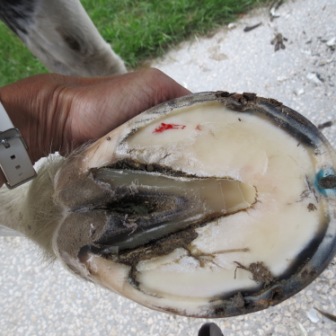 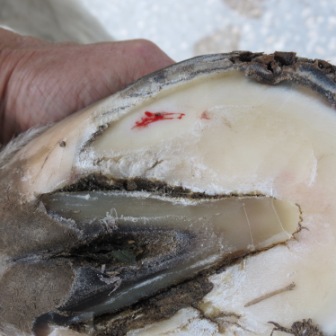 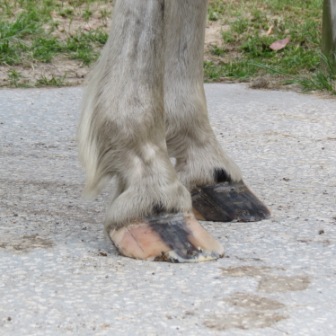 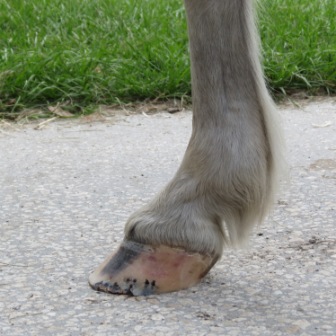 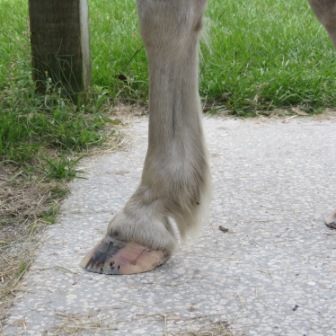 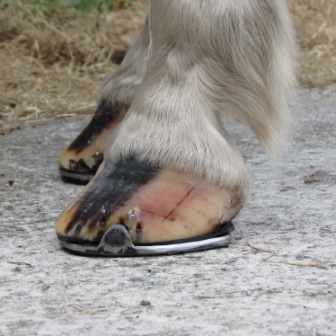 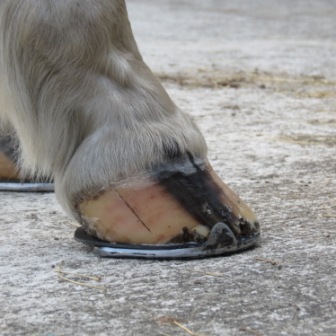 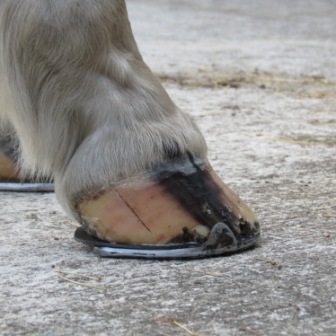  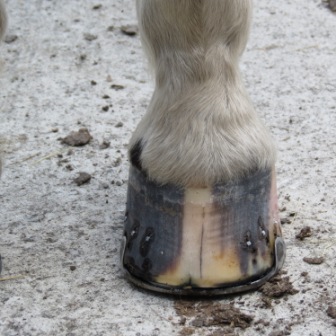 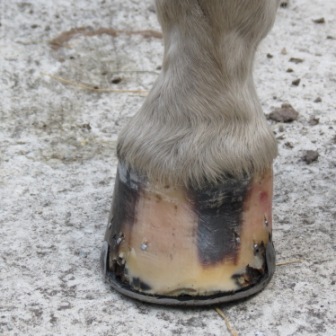 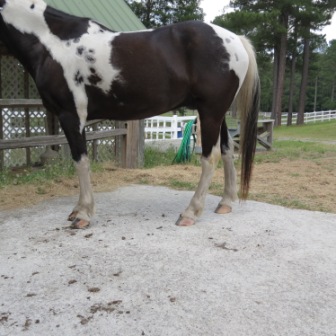
|
| Member: lsweeney |
Posted on Friday, May 11, 2012 - 7:24 pm: I'm going to throw my two cents in. I have an Arab who had laminitis in the front feet.The toes always want to be long. A lot of shoers want to do a traditional trim and follow that white line around with a normal hoof wall. However, if you do that, typically the toe will be left too long. My shoer retired, and the new guy was really leaving the toe too long. Additionally, the foundered feet want to grow pretty fast, and I really needed them corrected every 4 weeks or so. It was not possible for me to set up a schedule that would be worth it for a shoer to come out and touch up a barefoot horse in two feet. So I turned to my vet, and I said I'm going to start doing it myself. I read every natural horse trimming book and web page that is out there. That was about 15 years ago. I take a rasp only most of the time, and I keep the heels level with the frog. I rasp away any flares. I rasp off the toes so that the angle is consistent with the pastern and roll them. Sometimes that means that I'm taking off toe into the white line. This improves the breakover. Because I'm doing it myself, I can do subtle, gradual changes frequently. She was sound enough for me to ride her those 15 years with Easy Boots. She was and is barefoot when she is out in our pasture. In looking at the first shod pictures followed by this last batch, the hoof looks like it is in better position and the heel is lower, which is good. The toe doesn't look as long. You have to be careful taking the heel down quickly as the Deep Digital Flexor tendon goes over the fetlock and attaches to the coffin bone. As you lower the heel, it stretches this tendon. You don't want to put pressure on the front of the coffin bone as it can encourage it to rotate. https://www.localriding.com/image-files/health-hoof.jpg I just smile broadly when this 24 year old horse comes trotting up my driveway on pavement, barefoot. |
| Member: hollyh |
Posted on Friday, May 11, 2012 - 9:29 pm: Thanks for that.....It made me smile and again question what is best.....shoe or barefoot. When you have everybody saying "shoes"...and you come from a family of doctors...you just choose the best you have been programed to choose. I am working with this new 'therapy' for now....he says....'could be 2 years'. Asked me "How much do you love this horse?" I said "I will do anything I can for him". Easy is to sell him....Hard is to deal with the badness of his feet...but I keep asking myself "Is it a product of the years of bad farrier work that I never caught or is it genetics?"(or both?)....and I will NEVER sell him. He is just that good to me. I just want to make sure that the practitioners that I choose are not harming him in any way....and gain a better understanding of what may be causing his hoof to deteriorate.
|
| Member: vickiann |
Posted on Saturday, May 12, 2012 - 12:11 am: Hope that you are making some progress here.It does appear as though there is some amount of soft tissue distortion as in a couple of the photos the coronet seems lowest at the front center. I'm in the mountains with my horse right now for the summer months and will only add that my very excellent farrier feels that "less is more." Extra stuff like clips on the shoes, according to him, means that the foot is less able to flex and function. I've got my horse in very plain shoes and am riding him on the most rugged trails imaginable and he is going just great. I also have a horse who has had laminitis in the past who is totally sound while being barefoot on my mountain farm, but I do not take him on the very rugged mountain trails or places where there is extremely sharp gravel. Thanks to my farrier, his heels have been taken down to where they need to be post laminitis and he has no distortion. |
| Member: lsweeney |
Posted on Saturday, May 12, 2012 - 1:51 am: Holly, I think it takes about a year for the whole hoof to replace itself. I had a couple of laminitis episodes with my Arab in the beginning. I finally figured out that she was eating acorns on our property. (Fortunately for my husband who I was blaming for feeding her too much.) Anyway, with each episode I knew that I had a year of recovery waiting for me.I am sure that shoes have their place, and I'm for what works. However, I'm a big fan of the barefoot hoof for many reasons. For one, it is a hell of lot cheaper. I do ride in the high sierras over very difficult, rough terrain. But when I do that, I think boots are better than iron shoes. They don't slip on the granite rocks, they provide much better protection going over stream beds and shale, and my horses are very comfortable in them. If I lose one, I just put on another one. I don't need a shoer to fix the situation. I have three horses and we do their feet. I'm on 3 acres of mostly decomposed granite. So my horses wear their feet down without us doing much. I'm mostly touching up flares and maintaining the foundered mare. It is very cool. I love being independent. I've also been getting most of my boots from the hoofboot exchanges. People buy the wrong size all of the time, and there are great deals out there. |
| Moderator: DrO |
Posted on Sunday, May 13, 2012 - 5:59 pm: Hmmm, a little far forward for a corn (a bruise usually right in the angle of the heel often associated with sole pressure by the heel of the shoe) and with no surrounding yellow (serum) and red (blood) staining of the horn it really looks more like barely exposed corium. Is the horn very thin around it?Very subjectively, I do like the shorter foot and angles and with more heel coming off some amount of derotation may have occurred? I am not certain what information could be gotten from an MRI but retaking the radiographs might help with the rotation problem. For more on this see HorseAdvice.com » Diseases of Horses » Lameness » Diseases of the Hoof » Founder & Laminitis » Rehabilitation and Derotation of Foundered Horses. DrO |
| Member: hollyh |
Posted on Tuesday, May 15, 2012 - 11:16 am: He does not have the thickest soles but the last X-ray in the first of my posts is of this bleeding foot and it looks like enough sole??? I have never been told that this 'good' LF foot is worrisome with the 7 different sets of Xrays/vets that have looked at them. Quite possibly the farrier said 'corium' and with his southern accent I heard 'corn' He just was perplexed as to why he hit blood in that area. Thought there might be something going on in his feet with soft tissue that is not showing up on Xrays. I am not getting MRI at this time. Too expensive and not enough reason. I will take more photos in four weeks and post. Thank you for your input. Horse is sound. Do think the amount of heel taken off with adversely affect his tendons/ligaments. Should he go slower or is this adequate? He just was perplexed as to why he hit blood in that area. Thought there might be something going on in his feet with soft tissue that is not showing up on Xrays. I am not getting MRI at this time. Too expensive and not enough reason. I will take more photos in four weeks and post. Thank you for your input. Horse is sound. Do think the amount of heel taken off with adversely affect his tendons/ligaments. Should he go slower or is this adequate?
|
| Moderator: DrO |
Posted on Tuesday, May 15, 2012 - 9:30 pm: Hello Holly,No I don't think this will adversely effect his tendons. Go slower at what? DrO |
| Member: hollyh |
Posted on Wednesday, May 16, 2012 - 1:22 pm: I'm sorry. Slower at taking down his heels. |
| Moderator: DrO |
Posted on Wednesday, May 16, 2012 - 5:03 pm: I recommend 3 degrees at a time Holly,DrO |
| Member: leilani |
Posted on Wednesday, May 16, 2012 - 7:59 pm: Hi Holly,Just wanted to give you my 1cent. RE: "The consensus is that I live in such a moist, humid climate (SE GA) and in this climate this horses hoof wall cannot be stable, and when using boots...they trap moisture in the hoof and do not allow it to breathe/dry. (perfect environment for WLD/thrush) All claim that barefoot will hurt more than help." As has been said, boots would do wonders for this horse. You don't have to leave them on 24/7. Take them off and let the hoof breathe once in a while. My horses live in a humid environment all year round. Their feet are trimmed every 4 weeks and I do touch up in between. Going BF is much harder than putting metal shoes on them. Check out your options - for the horse. |
| Member: hollyh |
Posted on Wednesday, May 16, 2012 - 8:52 pm: Thanks....Will begin to decide on best option post summer mountain living. I am very open to attempting barefoot. A few horses at my barn have gone barefoot after farriers said they never could. After six plus months of nasty looking feet, they are faring better than when they had shoes....none had prior rotation. I just don't want the humid moisture and thin soles to allow for any more laminitis/rotation/sinking issues. This is my fear of going barefoot. |
| Member: babychop |
Posted on Wednesday, May 16, 2012 - 11:57 pm: Hey! I just stumbled across this and thought you might like to see that you're not the only one dealing with something like this.https://eventingakhaltekes.blogspot.com/2010/02/seedy-success.html I don't know how close it is to your situation but I immediately thought of you and thought you might like to check it out and maybe talk to them. |
| Member: hollyh |
Posted on Friday, May 18, 2012 - 1:28 pm: Thanks for that Andrea...Yes I've gone through many years of 'cow foot' I will attach 07-11 photos of his feet. Most taken in the summer except 09 which was taken in winter. These first are summer 07 after first resection for hollow foot white line. Blue is copper sulfate/vinegar soaks. I will attach 07-11 photos of his feet. Most taken in the summer except 09 which was taken in winter. These first are summer 07 after first resection for hollow foot white line. Blue is copper sulfate/vinegar soaks.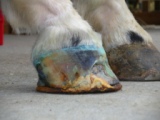 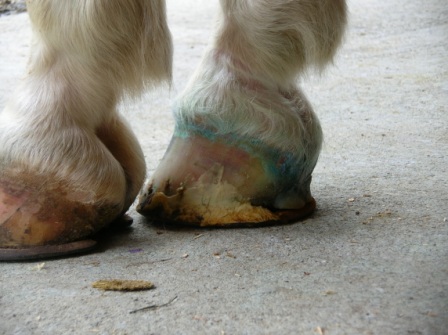 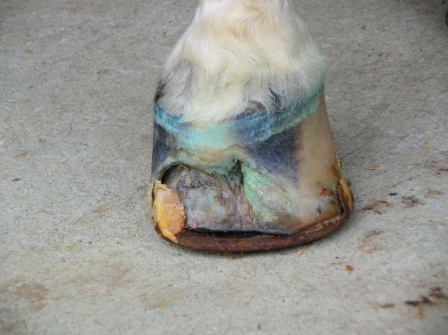
|
| Member: hollyh |
Posted on Friday, May 18, 2012 - 1:39 pm: Summer of 08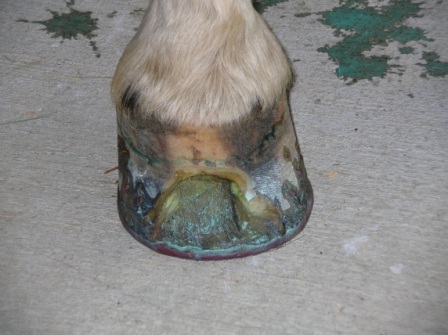 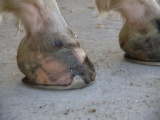 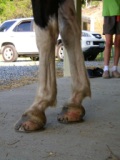
|
| Member: hollyh |
Posted on Friday, May 18, 2012 - 1:42 pm: November of 09 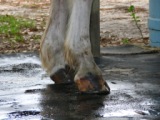
|
| Member: hollyh |
Posted on Friday, May 18, 2012 - 1:44 pm: Summer of 10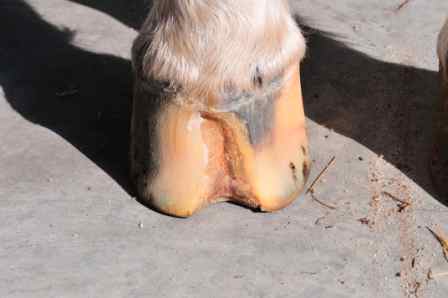 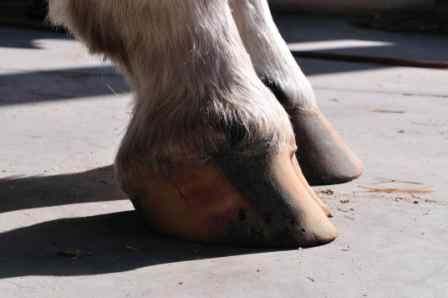 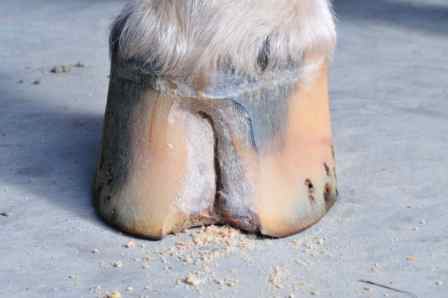  I then had a period of 1 year with very little issues until March of 12 when I posted the first photos above. |
| Member: babychop |
Posted on Friday, May 18, 2012 - 1:54 pm: Ugh, poor thing! Well, it sounds like they eventually found a solution, I hope you can for your pony's sake. I can't imagine your stress. |
| Moderator: DrO |
Posted on Saturday, May 19, 2012 - 8:13 am: Holly just prior to the next shoeing it might be helpful to get a good lateral radiograph of both fronts to guide the trimming to try and continue to work toward normal coffin bone to "hoof wall at the toe" and "ground relationships". It might also document if the sole is really that thin at the quarters.DrO |
| Member: hollyh |
Posted on Saturday, May 19, 2012 - 10:57 am: Will do. Probably not going to be next shoeing but the one after that as there is a travel/timing issue. My farrier in NC works for the vet clinic on certain 'hoof therapy' days and I need to time that. Thanks! Will post when I get. |
| Member: quatro |
Posted on Saturday, May 19, 2012 - 11:42 pm: WoW Holly, You and I could write a book on this. Levi is still giving me trouble, same thing. I have a million posts on white line, and pics on HA. I am still dealing with problems again this spring! |
| Member: hollyh |
Posted on Sunday, May 20, 2012 - 10:09 am: Yes Susan....I have been reading your posts as they seems to be very similar to my issues. Levi still barefoot? You ever try the Usnea or tea tree oil? I am using a Clorpactin spray (hospital wound cleaner you can order without prescription at the pharmacy- comes in powder form, you mix with water) and it works on what it can penetrate but I have tracts that run from sole to band that farriers are not willing to cut out and open for cleaning as they run a little too close to the inner structure of the hoof for their comfort. Spring is a flare time. It actually happened early this year for me in GA (February) and caught me by surprise because we have been in DrOught and had very little- if any new grass. I have begun to wonder if it is anything he is eating in the winter that could cause it (I feed him occasional wet Timmothy/alfalfa cubes to keep weight on him), if he is eating some type of pasture weed out of pure boredom or if it is just the increase in humidity that cause these flares. Let me know what is working for you! |
| Horseadvice has nearly 1000 Articles and 100,000 Discussions all written or moderated by an experienced equine veterinarian. To get full access to the articles or to post questions and answers to our active forums become a member! We have a membership that fits your budget: Come see what you have been missing. | |
is The Horseman's Advisor
Helping Thousands of Equestrians, Farriers, and Veterinarians Every Day
All rights reserved, © 1997 - 2025
